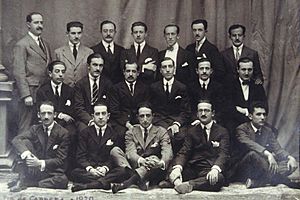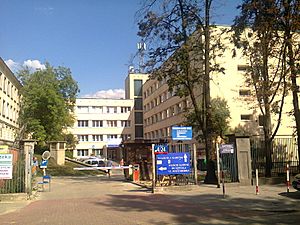Manuel Sánchez Arcas facts for kids
Quick facts for kids
Manuel Sánchez Arcas
|
|
|---|---|

Sánchez Arcas in Moscow in 1945
|
|
| Born | 1897 Madrid, Spain
|
| Died | 1970 (aged 72–73) Berlin, Germany
|
| Nationality | Spanish |
| Occupation | Architect and urban planner |
Manuel Sánchez Arcas (1897–1970) was a Spanish Modernist architect. This means he designed buildings in a new, modern style. During the Spanish Civil War (1936–1939), he worked for the Republican government. He was in charge of sharing information as the Undersecretary for Propaganda. After the war, he had to leave Spain and lived in Moscow, Warsaw, and Berlin.
Contents
Life Story
Early Years: 1897–1936
Manuel Sánchez Arcas was born in Madrid, Spain, in 1897. He studied architecture at the Madrid School of Architecture. He finished his studies in 1921. After graduating, he went to London to learn even more about architecture.
When he came back to Spain, he first worked with another architect named Secundino Zuazo. From 1925, he started working on his own. He was part of a group of architects called the "1925 generation." They wanted to bring new, modern ideas about building design to Spain.
Manuel Sánchez Arcas worked on a big project called the Madrid University City. This project was about designing and building a whole university campus. He worked with other young architects to create different buildings. Sánchez Arcas and Jesús Martí Martín designed a new building for historical studies.
In 1929, an engineer named Eduardo Torroja joined the team. He and Sánchez Arcas worked closely together. They both liked new building styles and didn't want to stick to old rules. Their first joint project was a pavilion for the university city, finished in 1931. They also designed the heating plant and the clinical hospital for the university.
A very famous project they worked on together was the market hall in Algeciras in 1932. They designed a unique, semi-circular concrete roof for it. This roof was only 9 centimetres (3.5 in) thick but was 47.5 metres (156 ft) high. It was held up by eight pillars. Many people consider this market hall to be Torroja's best engineering work.
Sánchez Arcas and Torroja also started a magazine called Hormigón y Acero, which means "Concrete and Steel." In 1934, they created an organization called the Instituto Técnico de la Construcción y Edificación (ITCE). This group worked to find and use new technical ideas in building and engineering.
During the Civil War: 1936–1939
Manuel Sánchez Arcas became a strong member of the Spanish Communist Party (PCE). The Spanish Civil War started in July 1936. This was a big conflict where Nationalists, led by Francisco Franco, rebelled against the government.
In November 1936, as Nationalist troops got close to Madrid, the government changed. Sánchez Arcas became an important part of the government. He was made the Undersecretary for Propaganda. This meant he helped manage how information was shared with the public.
Later, in January 1938, he was again appointed Undersecretary of Propaganda. He worked to manage the government's communication efforts. He also tried to save money by making changes to how the propaganda office worked. He personally handled important messages with foreign representatives. He also suggested selling books and pamphlets to cover their costs.
In March 1939, the Republican government faced another challenge from within. Prime Minister Juan Negrín and other leaders had to leave Spain by plane. Sánchez Arcas went with them.
Later Years: 1939–1970
After leaving Spain, Sánchez Arcas went to live in Russia. In 1946, the Spanish Republican government, which was now in exile, appointed him as their Minister in Warsaw, Poland. His reports to the exiled government often matched the ideas of Stalinist propaganda.
However, in 1947, the Communist Party left the exiled government. This made Sánchez Arcas's relationship with the government difficult. Poland also became less interested in supporting the exiled government.
Sánchez Arcas was one of the Spanish representatives at the World Congress of Peace in 1949. In February 1950, he had to leave his job as Spanish Minister. This was because of a political disagreement between Stalin and Josip Broz Tito of Yugoslavia. The exiled government supported Tito, which caused problems with Moscow.
Under pressure from Moscow, he stayed in Warsaw with his wife and daughters. In 1951, he started working as an architect again in Warsaw. In 1954, he became a member of the Central Committee of the PCE at a meeting in Prague. He later moved to Berlin, Germany, where he passed away in 1970.
Important Buildings
Here are some of the notable buildings Manuel Sánchez Arcas helped design:
- 1931 Hospital Provincial de Toledo, in Toledo, Spain
- 1932 Edificio Rockefeller, in Madrid, Spain (with Luis Lacasa)
- 1932 Central Térmica (Heating Plant), in Madrid, Spain (with Eduardo Torroja)
- 1935 Mercado de Algeciras (Algeciras Market), in Algeciras, Spain (with Eduardo Torroja)
- 1928–36 Hospital Clinico San Carlos de Madrid (with Eduardo Torroja)
Sources
See also
 In Spanish: Manuel Sánchez Arcas para niños
In Spanish: Manuel Sánchez Arcas para niños



